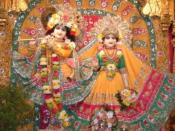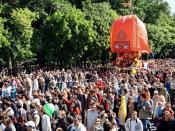Hinduism is the name given to one of the most ancient religion practices in India. Vedanta is the true name of this religion. When British rule began to populate India this ancient religion evolved into what is known today as Hinduism. Hinduism constitutes an extremely intricate religion upon which a single definition cannot be composed. The premier feature of this religion is the huge difference of beliefs and rituals among its practitioners.
Hinduism was created through the mixing of two distinct cultures involving the Aryans and the Indus Valley civilization. At about 1500 BC, the Aryan invaded India and imposed their religious themes on the Indian natives. Ultimately, the Aryan religion absorbed the rituals of the natives and was eventually transformed into Hinduism. Most Hindus are Indians or of Indian decent.
However, as Hinduism spread throughout Southeast Asia and Indonesia, other ethnic groups adopted Hinduism and added their own ethnic characteristics.
The major teachings of Hinduism state that salvation is achieved through a spiritual oneness of the soul, atman, with the ultimate reality of the universe, Brahma. To achieve this goal, the soul must obtain moksha, or liberation from the samsara, the endless cycle of birth, death, and rebirth.
Different sects of Hinduism teach different paths to moksha. As a result of these basic teachings, come Hindu beliefs in reincarnation, karma (material actions resulting from the consequences of previous actions), and the religious justification of the caste system. As Hinduism evolved, later texts came into prominence such as the Ramayana and the Mahabharata. The major text of the Vaishnavas is a portion of the Mahabharata known as the Bhagavad Gita.
The two largest sects of Hinduism are the Shivaite and the Vaishnavite sects, based upon the recognition of Shiva and Vishnu as the ultimate manifestations of Brahma. Vaishnavas constitute approximately...


